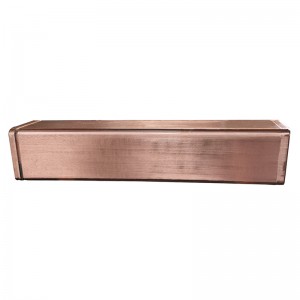Copper Tube Materials: Classified by Purity and Alloy Composition

The performance of copper tubes hinges on their material composition. From highly conductive pure copper to robust alloys, each type suits specific applications. Let’s explore the main categories.
- Pure Copper Tubes (Red Copper, ≥99.5% Copper Content)
Pure copper, or “red copper” due to its reddish-purple oxidized color, is valued for high purity. It offers excellent conductivity but is softer and costlier than alloys.
1. Common Grades:
a) T1 (≥99.95% copper): Top conductivity, used in high-precision electrical parts.
b) T2 (≥99.90% copper): Balances purity and cost, ideal for refrigeration pipelines and heat conductors.
c) T3 (≥99.70% copper): More impurities, reserved for non-critical structural parts like brackets.
d) TP2(phosphorus-deoxidized): Added phosphorus improves weldability and resists hydrogen embrittlement, perfect for air conditioner/refrigerator systems.
2. Traits: Great conductivity (≥90% IACS) and thermal transfer (≥380W/(m·K)), with better corrosion resistance than most brass. However, it’s soft (tensile strength 200-300MPa) and bends easily.
- Brass Tubes (Copper-Zinc Alloys, 50%-90% Copper)
Brass, a golden-yellow copper-zinc mix, is versatile and affordable, with properties adjusted by zinc or added elements.
1. Key Grades:
a) H62 (62% copper, 38% zinc): Moderate strength (300-400MPa), easy to machine—good for plumbing and decor, but avoid harsh environments.
b) H65 (65% copper, 35% zinc): More malleable, suited for complex shapes like heat exchanger fins.
c) HPb59-1 (lead brass): 1% lead eases machining (ideal for threads) but is toxic—no drinking water use.
d) HAl77-2 (aluminum brass): 2% aluminum enhances seawater resistance, used in marine settings.
2. Pros and Cons: Stronger and cheaper than pure copper, but lower conductivity (H62 has 25-30% of pure copper’s) and corrosion resistance drops with more zinc.
-
Special Bronzes (Industrial Heavyweights)
Bronzes, copper alloys with tin, aluminum, or beryllium (no zinc), excel in strength and durability for tough conditions, though they’re pricier.
Notable Types:
a) Tin Bronze (e.g., QSn6.5-0.1): Wear-resistant, used in bearings and high-pressure valves.
b) Aluminum Bronze (e.g., QAl9-4): High strength (≥600MPa) and corrosion resistance, for heavy machinery and chemical pipelines.
c) Beryllium Bronze (e.g., QBe2): Heat-treatable, strong, and conductive—for precision parts, but beryllium is toxic.
Each bronze type solves problems ordinary copper or brass can’t, making them vital for industrial extremes.
Understanding these categories helps select the right copper tube, ensuring performance, longevity, and cost-effectiveness.
Check our copper mould tube options, non-standard copper mould tubes are also available.
Post time: Jul-25-2025